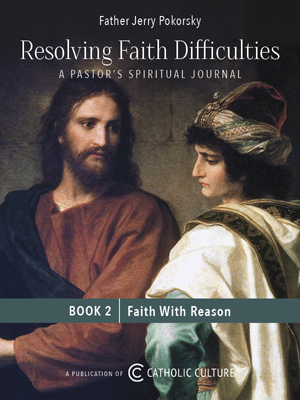Why the Faithful Departed, and How to Get Them Back
By Dr. Jeff Mirus ( bio - articles - email ) | Feb 29, 2008
It’s a powerful book that forces you to understand the grim malaise of the Catholic Church in the United States. It’s about much more than the sex abuse scandal. It’s about bishops who see the Church primarily as a public institution to be governed and protected by political strategies. This book is both riveting and devastating. I refer to Phil Lawler’s The Faithful Departed: The Collapse of Boston’s Catholic Culture.
First a disclaimer: Philip F. Lawler is the founder and director of Catholic World News, which for the past two years has been owned by Trinity Communications. Before that, we collaborated on various projects for a decade or more. Readers can take this as an indication of both bias and profound respect. However you take it, Lawler’s book is a brilliant achievement.
The Rise and Fall of Boston’s Catholic Empire
The Faithful Departed is a study of how the Church in Boston rose from despised minority status to become the controlling influence in Boston’s public life, and then how it crashed and burned so that a majority of citizens and political leaders, who call themselves Catholic, now consistently flout the teachings of the Church and ignore the directives of the hierarchy on everything from private behavior to public policy. Although Boston is a particularly dramatic case, the author is well aware that the story is paradigmatic of the Church in the United States as a whole. When necessary, he draws in the larger picture. This is the story of an immense cultural and ecclesiastical shift, and it is a cautionary tale.
While Lawler amply documents the extent of clerical sex abuse, including the pervasive influence of a homosexual network and the massive cover-up, his thesis is much deeper and more comprehensive. Lawler argues persuasively that the root of the problem is the failure of the Catholic bishops to view the Church as an institution that depends on God and instead to view it as a public entity which can only survive and prosper through political and bureaucratic management: alliances with the powerful, compromise, image protection, public role-playing, policies and programs. In an era when the dominant secular culture was becoming increasingly hostile to traditional spirituality, and the Church herself was unfortunately confused about God, grace, doctrine and sin, the bishops consistently sought to preserve the Church’s public image—and their own image—rather than face the Church’s internal problems directly and uncompromisingly in the spirit of Christ.
Lies, Damn Lies
The result was a Church in which every internal problem was ignored at all costs and where most bishops continued to proclaim that all was well and that their churches were thriving. In so doing, they consistently lied to themselves and, more culpably, to their people, to public officials, and even to Rome. Lawler puts the case neatly:
In his Confessions St. Augustine argued that unswerving fidelity to orthodox doctrine and utter reliance on God’s grace are the only reliable ways to ensure the success of the faith. God watches over the Church, the great theologian reasoned, and “God does not need my lie.” It is difficult to think of a proposition more radically contrary to the American Church leadership of our time. (134)
What is most devastating about The Faithful Departed is that the author has no illusions that the crisis is past. The problem of abusive priests—who are a tiny minority—has been admitted and a zero-tolerance policy implemented. But the much deeper problem of complicity, cover-up, deceit, and utter failure to care spiritually for the laity has not been admitted. Yet this problem, now equally documented, has been caused by a clear majority of bishops. Nonetheless, with a few notable exceptions, the U.S. episcopate continues in the same old patterns, presiding over ever-shrinking and ever-poorer dioceses, hoping to maintain a modicum of prestige, with each bishop hoping to avoid the appearance of yet more scandal on his watch (“scandal” being defined as the public discovery of evil). The dignity, power and influence of the American episcopate are no more visible than the emperor’s new clothes, yet the charade continues. The root spiritual problems of the Church continue to be ignored; the same old secularized experts continue to be consulted; defensive policies are driven not by saints but by attorneys. Rarely has such a great tragedy been at the same time so utterly and obviously ludicrous.
Shooting the Messenger
Over the past forty years, the overwhelming majority of faithful Catholics who have attempted to combat the moral and doctrinal confusion infecting the Catholic Church have suffered two heart-rending experiences. The first was their painful astonishment when they learned that the doctrinal, moral and liturgical problems they faced were supported by their pastors. The second was their black despair when they found that they themselves had been identified by their bishops as the “real” cause of the problem. Lawler captures the situation perfectly:
A bishop, Vatican II had taught (Lumen Gentium, 23), is the “visible source and foundation of unity” in his diocese. American bishops fulfilled this role in a very odd way: not by restoring unity, but by declaring it. Since the bishop had announced that the local Church was one happy family, anyone who pointed out divisions was offending against that unity, fomenting discord, and subverting the bishop’s authority at the same time. The greatest threat to the integrity of the Catholic faith was not someone who denied fundamental Church teachings, but someone who called attention to that denial, thereby fracturing the façade of unity. The bishops had found a foolproof way to blame the messenger for bringing bad news. (125)
Many Catholic lay persons have worked for decades to expose not only sexual abuse, but false doctrine, contradiction of the Church’s moral teachings, denial of their rights as parents, and great deformities in Divine worship. Most have been stonewalled by priests and bishops, sometimes by successive bishops, who have often simply refused to take their calls. Even when one of these faithful lay persons has obtained an unlikely promise of investigation or corrective action, they have waited in vain for anything to be done. They have had to start all over again, repeatedly, until finally giving up in total frustration. This pattern of “pastoral care” is so ingrained in the ecclesiastical bureaucracy that one wonders, in most dioceses, whether the bishops and their immediate subordinates know how to do anything other than protect themselves while attempting to save face.
Reasons for Hope
Phil Lawler argues persuasively that hope does not lie in what has already been done. The net result of the initial measures taken following the sex abuse crisis is that “all priests were now treated like members of a suspect class, while bishops preserved all their dignity and privileges” (191). Instead, the author argues that the solution must match the problem. The problem is precisely the problem posed by Augustine. Therefore, the solution must begin with a frank and contrite admission that the bishops themselves have administered their dioceses from a position of spiritual bankruptcy. Only then can the necessary renewal begin, an interior renewal which causes our shepherds to once again view the Church as the body of Christ, utterly dependent on the truth and grace of the Savior—a Church which will in fact always be hurt by complacency, worldliness, secular processes, political management techniques and, yes, lies.
Lawler inescapably concludes that “for the Catholic Church in Boston today, there is no earthly hope” (252). But he goes on to make his larger point unmistakably clear:
The Catholic Church has never had any earthly hope…. No, the Apostles had something much more powerful than any earthly hope. Since they could not place their confidence in any logical process, or any material resources, they relied entirely on the power of the Holy Spirit. And they succeeded. (254-5)
The Faithful Departed is not only a cautionary tale, but an extremely well-told cautionary tale with a properly constructive purpose. The book reminds one forcefully of baptism, for in and through this account of our Church we experience a sort of dying with Christ—the painful and at times horrifying death of the “old man”, the self. But it is a dying in order to rise. Phil Lawler knows that even bishops can participate in this dying. He invites them to do so. Therefore the promise of Resurrection remains.
All comments are moderated. To lighten our editing burden, only current donors are allowed to Sound Off. If you are a current donor, log in to see the comment form; otherwise please support our work, and Sound Off!








